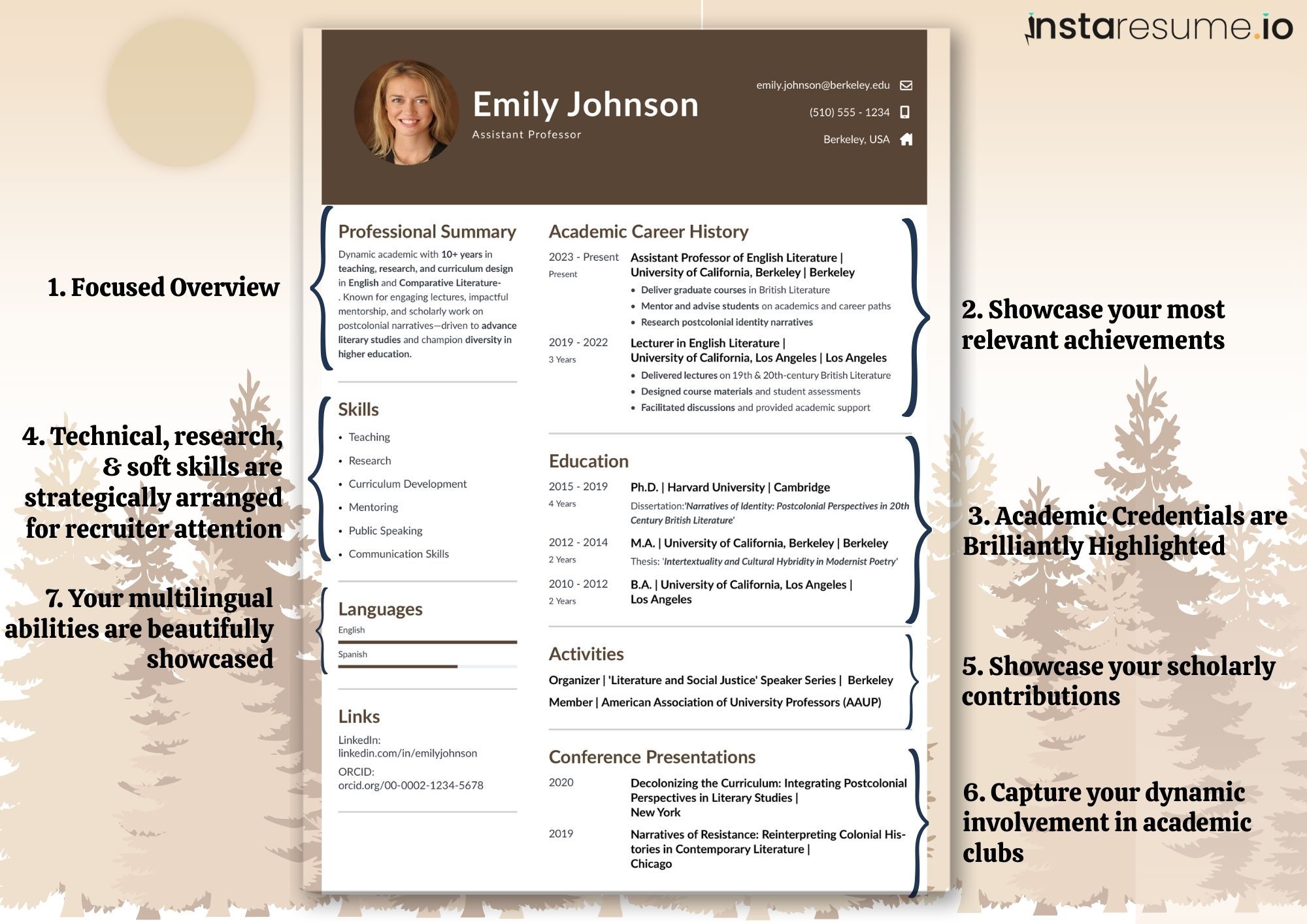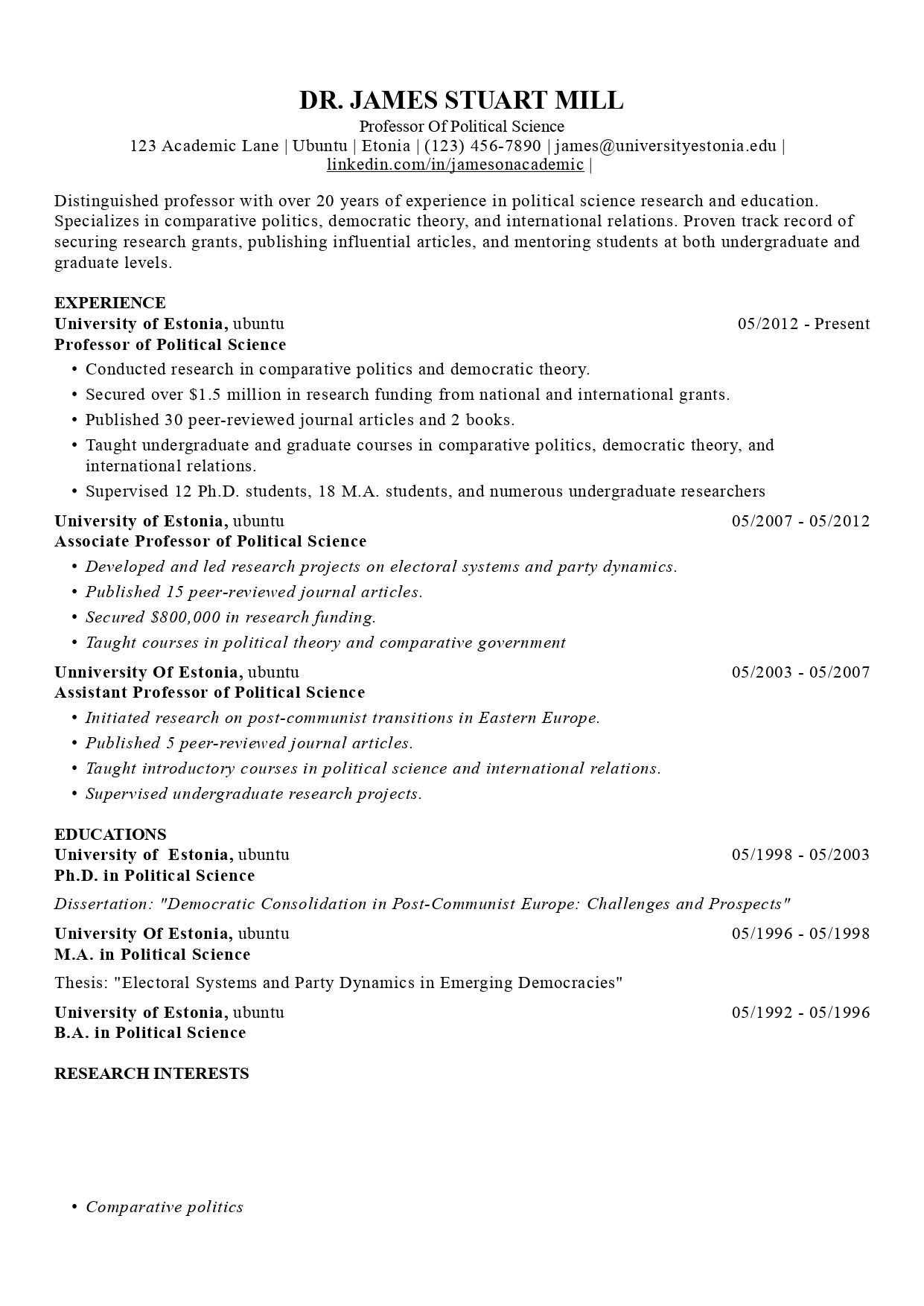Academic Resume Template: How to Create a Professional Academic CV for Success
Trust Score: 4.8
353 reviews

Table of Contents
Introduction to Academic Resume Templates
An academic resume template serves as a structured framework to showcase your qualifications, research contributions, and teaching experience in a professional, well-organized format. Unlike a regular job resume, which highlights work experience and skills for corporate roles, an academic resume (or CV) is designed to reflect your scholarly achievements, publications, fellowships, and educational background in detail.
Importance of an Academic Resume for Research and Teaching Positions
In the world of academia, your resume acts as your professional identity. Whether you are applying for a teaching position, post-doctoral research role, fellowship, or academic scholarship, selection committees rely heavily on your resume to evaluate:
 Depth of research experience and scholarly contributions
Depth of research experience and scholarly contributions Teaching capabilities and subject expertise
Teaching capabilities and subject expertise Awards, grants, and academic recognitions
Awards, grants, and academic recognitions Potential for contributing to the institution’s research goals
Potential for contributing to the institution’s research goals
A strong academic resume not only highlights your accomplishments but also establishes your credibility as a dedicated academic professional.
Difference Between an Academic Resume and a Professional Resume
While both are meant to showcase qualifications and achievements, the focus and structure differ significantly:
 Length & Detail: Academic resumes (CVs) are usually longer, often 2–5 pages, covering every publication, presentation, and research project. Professional resumes are usually 1–2 pages and highlight only recent, relevant experience.
Length & Detail: Academic resumes (CVs) are usually longer, often 2–5 pages, covering every publication, presentation, and research project. Professional resumes are usually 1–2 pages and highlight only recent, relevant experience. Content Focus: Academic CVs emphasize education, research, publications, teaching experience, awards, and grants, while professional resumes focus on skills, work experience, and career achievements.
Content Focus: Academic CVs emphasize education, research, publications, teaching experience, awards, and grants, while professional resumes focus on skills, work experience, and career achievements. Purpose: An academic resume is evaluated by professors, researchers, or selection committees, whereas a professional resume is screened by HR recruiters or hiring managers.
Purpose: An academic resume is evaluated by professors, researchers, or selection committees, whereas a professional resume is screened by HR recruiters or hiring managers.
How the Right Template Improves Selection Chances
A well-structured academic resume template can significantly improve your chances of landing interviews or selection for fellowships and academic roles because:
 It organizes information clearly, making it easier for the selection committee to assess your qualifications quickly.
It organizes information clearly, making it easier for the selection committee to assess your qualifications quickly. It ensures consistency and professional formatting, which reflects attention to detail.
It ensures consistency and professional formatting, which reflects attention to detail. ATS-friendly and clean layouts help avoid rejection in universities or research institutions using applicant tracking systems.
ATS-friendly and clean layouts help avoid rejection in universities or research institutions using applicant tracking systems. A tailored template allows you to emphasize publications, research projects, and teaching experience, giving you a competitive edge over other applicants.
A tailored template allows you to emphasize publications, research projects, and teaching experience, giving you a competitive edge over other applicants.
Key Components of an Academic Resume
An academic resume template is most effective when it includes all the essential sections that highlight your scholarly achievements, research work, and teaching expertise. Unlike a professional resume, which focuses on work experience and skills, an academic resume (or CV) is comprehensive and detail-oriented.
Here are the key components every academic CV should include:
1. Contact Information and Professional Profile
 Include your full name, designation, email, phone number, LinkedIn, and institutional affiliation.
Include your full name, designation, email, phone number, LinkedIn, and institutional affiliation. A short professional summary or career objective can briefly state your area of expertise, research interest, and academic goals.
A short professional summary or career objective can briefly state your area of expertise, research interest, and academic goals. Example:
Example:
“Ph.D. candidate in Political Science specializing in electoral behavior and narrative strategies, with published research on political perception-building.”
2. Educational Qualifications
 List degrees in reverse chronological order (latest first).
List degrees in reverse chronological order (latest first). Include institution name, degree, year of completion, and thesis title (if applicable).
Include institution name, degree, year of completion, and thesis title (if applicable). Mention honors, distinctions, or relevant coursework if they strengthen your profile.
Mention honors, distinctions, or relevant coursework if they strengthen your profile.
3. Research Experience
 Highlight your research projects, lab experience, or fieldwork relevant to your academic domain.
Highlight your research projects, lab experience, or fieldwork relevant to your academic domain. Include project titles, funding details, methodologies, and outcomes if notable.
Include project titles, funding details, methodologies, and outcomes if notable. Mention collaborations with professors or research groups to showcase teamwork in academic work.
Mention collaborations with professors or research groups to showcase teamwork in academic work.
4. Teaching Experience
 Essential for applicants targeting lecturer, professor, or teaching assistant roles.
Essential for applicants targeting lecturer, professor, or teaching assistant roles. Include subject taught, institution, duration, and responsibilities.
Include subject taught, institution, duration, and responsibilities. If you conducted seminars, workshops, or guest lectures, highlight them to demonstrate academic engagement.
If you conducted seminars, workshops, or guest lectures, highlight them to demonstrate academic engagement.
5. Publications and Presentations
 Crucial for academic credibility. Include:
Crucial for academic credibility. Include:  Journal publications (peer-reviewed preferred)
Journal publications (peer-reviewed preferred) Conference papers and poster presentations
Conference papers and poster presentations Book chapters, articles, or reports
Book chapters, articles, or reports
 Follow standard citation style (APA/MLA/Chicago) for authenticity.
Follow standard citation style (APA/MLA/Chicago) for authenticity.
6. Awards, Grants, and Fellowships
 Showcase recognitions that establish your academic merit.
Showcase recognitions that establish your academic merit. Include scholarships, funded research grants, or competitive fellowships with awarding body and year.
Include scholarships, funded research grants, or competitive fellowships with awarding body and year.
7. Skills and Technical Proficiency
 List domain-specific skills like data analysis software (SPSS, R), coding languages, or lab techniques.
List domain-specific skills like data analysis software (SPSS, R), coding languages, or lab techniques. Mention soft skills relevant to academia, like public speaking, research writing, and collaboration.
Mention soft skills relevant to academia, like public speaking, research writing, and collaboration.
8. References (Optional but Recommended)
 Include 2–3 academic referees, usually professors or supervisors familiar with your work.
Include 2–3 academic referees, usually professors or supervisors familiar with your work. Format: Name, Title, Institution, Email, and Phone Number.
Format: Name, Title, Institution, Email, and Phone Number.
A well-structured academic resume template with these components will ensure all your achievements are visible, increasing your chances of selection for academic jobs, research fellowships, or scholarships.
Choosing the Right Academic Resume Template
Selecting the right academic resume template can significantly influence how your credentials are perceived by selection committees. A well-structured and ATS-friendly academic CV ensures that your qualifications, research achievements, and teaching experience are presented clearly and professionally, improving your chances of shortlisting for academic jobs, research fellowships, or higher education opportunities.
Modern vs. Traditional Academic Resume Formats
Academic resumes can follow either a traditional or a modern format, and your choice should reflect your target role and institution.
 Traditional Academic Resume (CV)
Traditional Academic Resume (CV)  Focuses on text-heavy and linear layouts
Focuses on text-heavy and linear layouts Minimal or no design elements
Minimal or no design elements Best suited for universities, government institutions, or conservative academic fields
Best suited for universities, government institutions, or conservative academic fields
 Modern Academic Resume Template
Modern Academic Resume Template  Clean design with section highlights and subtle formatting
Clean design with section highlights and subtle formatting Easier for selection committees to navigate
Easier for selection committees to navigate Ideal for international applications, interdisciplinary research roles, and hybrid academic-industry positions
Ideal for international applications, interdisciplinary research roles, and hybrid academic-industry positions
Free vs. Premium Academic CV Templates
When creating an academic CV, you can choose between free and premium templates depending on your requirements:
 Free Academic Resume Template
Free Academic Resume Template  Easily available online
Easily available online Simple, functional, and suitable for students or entry-level applicants
Simple, functional, and suitable for students or entry-level applicants May require manual formatting adjustments to meet ATS standards
May require manual formatting adjustments to meet ATS standards
 Premium Academic Resume Template
Premium Academic Resume Template  Professionally designed with polished formatting and ATS optimization
Professionally designed with polished formatting and ATS optimization Offers editable layouts, PDF support, and section flexibility
Offers editable layouts, PDF support, and section flexibility Recommended for professors, postdoctoral applicants, and competitive fellowship candidates
Recommended for professors, postdoctoral applicants, and competitive fellowship candidates
Importance of Professional and ATS-Friendly Design
A professional academic resume design is more than aesthetics; it directly impacts your selection chances. Applicant Tracking Systems (ATS) are increasingly used by universities and research institutions to filter applications, and a poorly formatted CV may fail to pass initial screenings.
 Professional formatting ensures readability for both ATS and human reviewers
Professional formatting ensures readability for both ATS and human reviewers Clear sectioning helps committees quickly assess your research, teaching, and publications
Clear sectioning helps committees quickly assess your research, teaching, and publications Minimalist, ATS-friendly layouts prevent technical issues during online submissions
Minimalist, ATS-friendly layouts prevent technical issues during online submissions
By choosing the right academic resume template, you not only organize your achievements effectively but also increase your visibility in competitive academic applications, whether for university positions, scholarships, or research fellowships.
Step-by-Step Guide to Writing an Academic Resume
Crafting an academic resume (CV) requires more than just listing your degrees and experiences—it needs to strategically highlight your research, teaching, and scholarly contributions to meet the expectations of academic selection committees. A well-structured and ATS-friendly academic CV ensures your achievements are easy to scan and compelling to reviewers. Follow these step-by-step instructions to create a professional academic resume that increases your chances of landing research positions, fellowships, or academic jobs.
Academic CV
This academic CV provides a comprehensive overview of a professor's qualifications in political science, emphasizing their education, professional experience, research interests, publications, grants, teaching experience, awards, professional affiliations, and references. Adjust the sections and content to fit your specific background and achievements.
Step 1: Start with Contact Information and a Professional Summary
Your resume should begin with your name, current academic status, and contact details such as email, phone number, LinkedIn profile, or personal academic website.
 Add a professional summary of 2–3 lines, highlighting your research interests, teaching focus, or career objective.
Add a professional summary of 2–3 lines, highlighting your research interests, teaching focus, or career objective. Example:
Example:
“Ph.D. candidate in Political Science focusing on electoral behavior and political narratives, with 3+ years of research experience and multiple publications in peer-reviewed journals.”
Step 2: Highlight Educational Qualifications
Education is the backbone of your academic resume.
 List your degrees in reverse chronological order (latest first).
List your degrees in reverse chronological order (latest first). Include institution name, degree, graduation year, and thesis/dissertation title.
Include institution name, degree, graduation year, and thesis/dissertation title. Mention academic distinctions, honors, or scholarships if they strengthen your profile.
Mention academic distinctions, honors, or scholarships if they strengthen your profile.
Step 3: Showcase Research Experience
Your research work is a core component that reflects your academic depth and credibility.
 List projects, labs, or research collaborations with timelines and roles.
List projects, labs, or research collaborations with timelines and roles. Highlight funded projects, research methodologies, or published outcomes.
Highlight funded projects, research methodologies, or published outcomes. Example:
Example:
“Conducted qualitative research on electoral narrative strategies, contributing to a published paper in the Indian Political Science Review (2024).”
Step 4: Include Teaching Experience (If Applicable)
For lecturer, teaching assistant, or professor roles, teaching experience is crucial.
 Mention courses taught, subjects handled, duration, and key responsibilities.
Mention courses taught, subjects handled, duration, and key responsibilities. Highlight student mentoring, syllabus development, or workshop facilitation if relevant.
Highlight student mentoring, syllabus development, or workshop facilitation if relevant. Example:
Example:
“Served as Teaching Assistant for ‘Comparative Politics,’ assisting in curriculum design and leading weekly tutorial sessions for 50+ students.”
Step 5: Add Publications, Presentations, and Academic Contributions
Academic credibility heavily relies on peer-reviewed publications and conference contributions.
 Include journal articles, conference papers, book chapters, or working papers in standard citation format (APA/MLA/Chicago).
Include journal articles, conference papers, book chapters, or working papers in standard citation format (APA/MLA/Chicago). Add poster presentations, invited talks, or workshops conducted.
Add poster presentations, invited talks, or workshops conducted. For digital credibility, hyperlink to published papers if allowed.
For digital credibility, hyperlink to published papers if allowed.
Step 6: Highlight Awards, Grants, and Fellowships
Selection committees value candidates with recognized achievements.
 Include scholarships, research grants, fellowships, and awards with the awarding body and year.
Include scholarships, research grants, fellowships, and awards with the awarding body and year. Example:
Example:
“Recipient of UGC Junior Research Fellowship (2023) for doctoral research on Indian electoral narratives.”
Step 7: List Skills and Technical Proficiency
Your skills section should combine technical competencies and academic-relevant abilities:
 Research tools: SPSS, R, NVivo, LaTeX
Research tools: SPSS, R, NVivo, LaTeX Data skills: Quantitative & Qualitative Analysis, Survey Design
Data skills: Quantitative & Qualitative Analysis, Survey Design Soft skills: Research writing, Public speaking, Collaboration
Soft skills: Research writing, Public speaking, Collaboration
Step 8: Add References (Optional but Recommended)
Strong academic references add credibility and weight to your CV.
 Include 2–3 referees, preferably professors, supervisors, or research mentors.
Include 2–3 referees, preferably professors, supervisors, or research mentors. Format: Name, Designation, Institution, Email, Phone Number.
Format: Name, Designation, Institution, Email, Phone Number.
By following this step-by-step approach, you will create an academic resume template that is comprehensive, professional, and ATS-friendly, ensuring your scholarly profile stands out in highly competitive academic environments.
Common Mistakes to Avoid in an Academic Resume
Even the most qualified candidates can lose opportunities if their academic resume (CV) is poorly structured or contains errors. Academic resumes are evaluated by professors, selection committees, and sometimes ATS (Applicant Tracking Systems), so accuracy and organization are crucial. Avoiding common mistakes can significantly increase your selection chances for research positions, fellowships, or academic jobs.
1. Overloading the Resume with Irrelevant Information
 Many candidates include personal details, unrelated work experience, or excessive extracurriculars that dilute the impact of their academic credentials.
Many candidates include personal details, unrelated work experience, or excessive extracurriculars that dilute the impact of their academic credentials. Focus on:
Focus on:  Education
Education Research
Research Publications
Publications Teaching experience
Teaching experience Awards and grants
Awards and grants
 Keep the resume scholarly and concise, especially for university and higher education applications.
Keep the resume scholarly and concise, especially for university and higher education applications.
2. Poor Formatting and Lack of Structure
 An academic resume must be organized, professional, and ATS-friendly.
An academic resume must be organized, professional, and ATS-friendly. Mistakes to avoid:
Mistakes to avoid:  Using inconsistent fonts or spacing
Using inconsistent fonts or spacing Not separating sections clearly (e.g., research vs. teaching)
Not separating sections clearly (e.g., research vs. teaching) Submitting a resume that is difficult to scan for committees
Submitting a resume that is difficult to scan for committees
 Use a university CV template or higher education resume template to maintain a clean, professional look.
Use a university CV template or higher education resume template to maintain a clean, professional look.
3. Ignoring Publications and Research Impact
 Publications, conference papers, and research contributions are the backbone of an academic CV.
Publications, conference papers, and research contributions are the backbone of an academic CV. Common mistakes include:
Common mistakes include:  Listing publications without proper citation format
Listing publications without proper citation format Skipping DOI links or journal details
Skipping DOI links or journal details Not highlighting research that aligns with the role or scholarship
Not highlighting research that aligns with the role or scholarship
 A research CV template ensures publications are prominently visible, which is critical for professorships or postdoctoral positions.
A research CV template ensures publications are prominently visible, which is critical for professorships or postdoctoral positions.
4. Not Tailoring the Resume to the Role
 Sending a generic CV to all academic roles can harm your chances.
Sending a generic CV to all academic roles can harm your chances. Tailor each application by:
Tailor each application by:  Placing teaching experience first for lecturer roles
Placing teaching experience first for lecturer roles Highlighting research and publications for research positions
Highlighting research and publications for research positions Emphasizing awards, fellowships, and proposals for scholarships or grants
Emphasizing awards, fellowships, and proposals for scholarships or grants
5. Submitting Without Proofreading
 Typos, grammatical errors, and formatting inconsistencies create a negative impression.
Typos, grammatical errors, and formatting inconsistencies create a negative impression. Always:
Always:  Proofread thoroughly
Proofread thoroughly Double-check citations and dates
Double-check citations and dates Ensure the PDF version is properly formatted and ATS-friendly
Ensure the PDF version is properly formatted and ATS-friendly
By avoiding these mistakes and using a professional, structured, and keyword-optimized academic resume template, you can maximize your visibility in highly competitive academic environments.
Conclusion & Call-to-Action
A polished academic resume (CV) is more than just a document—it is your academic identity and a reflection of your research, teaching, and scholarly achievements. Whether you are applying for a university position, fellowship, postdoctoral research, or an academic scholarship, a well-structured academic resume template ensures that your qualifications are clearly presented, ATS-friendly, and compelling to selection committees.
Creating an organized and visually clean resume not only highlights your educational background, research contributions, and publications but also sets you apart in a highly competitive academic field. A thoughtfully prepared CV can be the deciding factor between being shortlisted or overlooked.
To make the process easier:
 Download or create your own academic resume using professional templates to save time and maintain consistency.
Download or create your own academic resume using professional templates to save time and maintain consistency. Use platforms and tools like Canva, Overleaf (LaTeX for academic CVs), Microsoft Word templates, and Google Docs for quick, editable, and ATS-friendly resumes.
Use platforms and tools like Canva, Overleaf (LaTeX for academic CVs), Microsoft Word templates, and Google Docs for quick, editable, and ATS-friendly resumes. Tailor each resume to the specific academic opportunity, highlighting the sections most relevant to the role, whether it’s research-focused or teaching-oriented.
Tailor each resume to the specific academic opportunity, highlighting the sections most relevant to the role, whether it’s research-focused or teaching-oriented.
Take action today—start building a professional academic CV that showcases your expertise, maximizes your selection chances, and positions you for success in academia.
Frequently Asked Questions (FAQs) About Academic Resume Templates
Here are some common questions candidates have when creating an academic resume (CV) for universities, research positions, and scholarships:
1. What is the difference between an academic resume and a professional resume?
An academic resume (CV) is typically longer and more detailed, focusing on education, research, publications, and teaching experience. A professional resume is usually 1–2 pages and highlights skills, work experience, and career achievements relevant to corporate or non-academic jobs.
2. How long should an academic CV be?
 Entry-level or student academic resumes: 1–2 pages
Entry-level or student academic resumes: 1–2 pages Postdoctoral or professor-level resumes: 3–5 pages or longer if you have extensive publications and research experience
Postdoctoral or professor-level resumes: 3–5 pages or longer if you have extensive publications and research experience
The goal is to showcase all scholarly achievements without unnecessary filler.
3. What sections should I include in my academic resume?
A strong academic CV template typically includes:
 Contact Information & Professional Summary
Contact Information & Professional Summary Educational Qualifications
Educational Qualifications Research Experience & Projects
Research Experience & Projects Teaching Experience
Teaching Experience Publications & Presentations
Publications & Presentations Awards, Grants, and Fellowships
Awards, Grants, and Fellowships Skills & Technical Proficiency
Skills & Technical Proficiency References (Optional)
References (Optional)
4. Which format is best for academic resumes: modern or traditional?
 Traditional format: Best for conservative universities or research roles, focusing on a text-heavy layout.
Traditional format: Best for conservative universities or research roles, focusing on a text-heavy layout. Modern format: Suitable for international applications and interdisciplinary research, with clean sections and subtle design highlights.
Modern format: Suitable for international applications and interdisciplinary research, with clean sections and subtle design highlights.
5. Can I use a free academic resume template?
Yes. Free academic resume templates are available on platforms like Canva, Google Docs, and Microsoft Office. However, premium templates often provide polished formatting, ATS optimization, and customizable layouts, making them more suitable for competitive applications.
6. How do I make my academic resume ATS-friendly?
To ensure Applicant Tracking System compatibility:
 Use standard fonts (Arial, Times New Roman, Calibri)
Use standard fonts (Arial, Times New Roman, Calibri) Avoid excessive graphics or tables
Avoid excessive graphics or tables Use consistent headings and bullet points
Use consistent headings and bullet points Save in PDF or DOCX format, depending on application instructions
Save in PDF or DOCX format, depending on application instructions
7. Do I need to include references in an academic CV?
Including 2–3 academic references is highly recommended, especially for teaching or research roles. Provide:
 Name and Designation
Name and Designation Institution
Institution Email and Phone Number
Email and Phone Number
A well-prepared academic resume that follows these guidelines and best practices can significantly improve your chances of selection for academic jobs, research opportunities, or scholarships.








